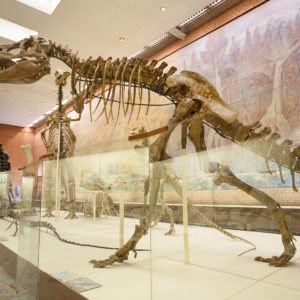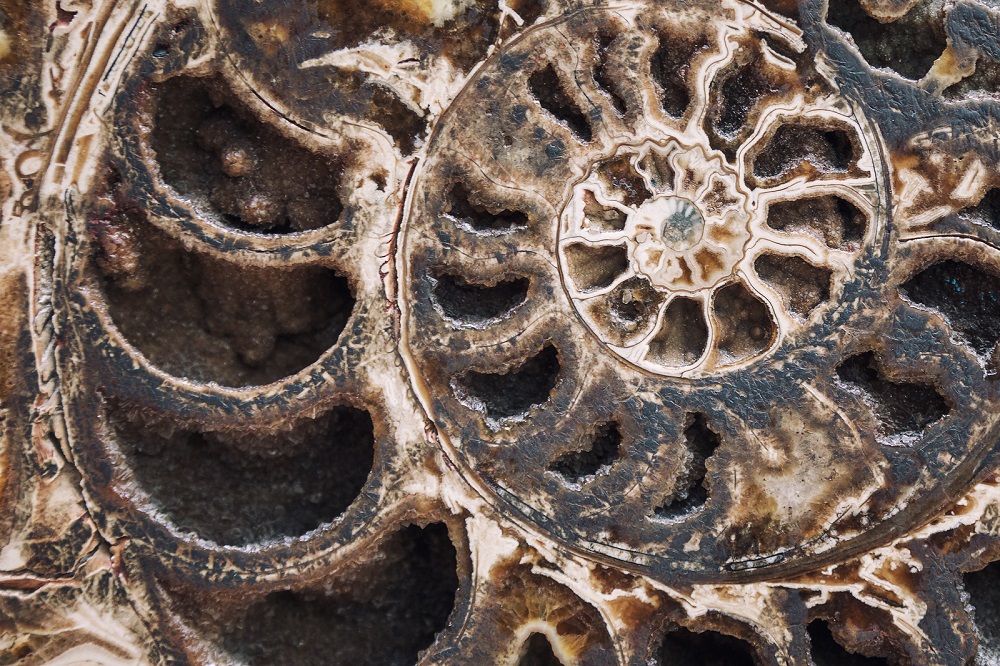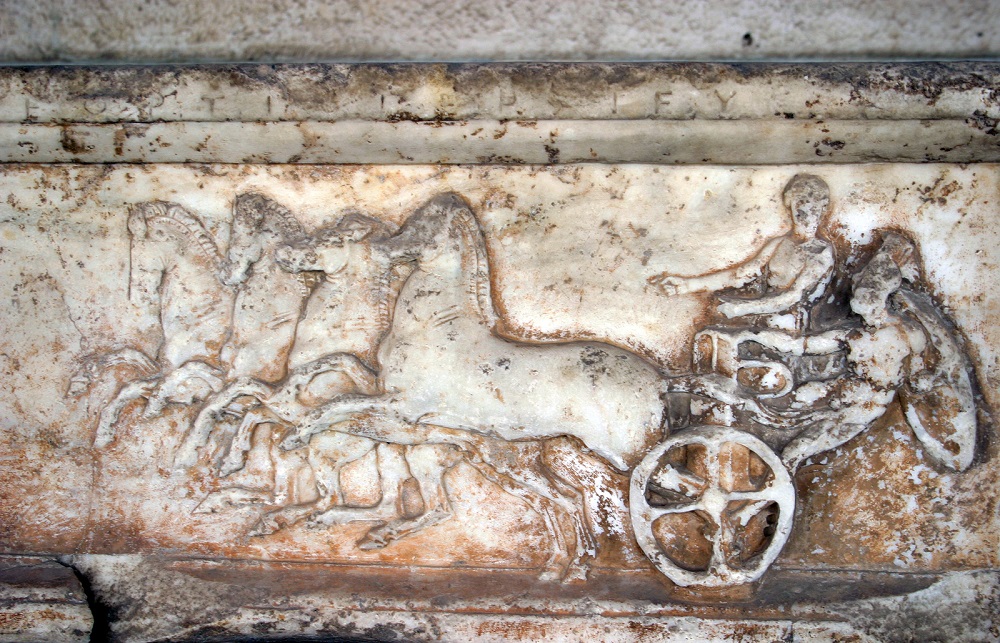
What is Paleontology?
As with most areas of science, the word “paleontology” has its origins in the Greek language. The word is broken down into three sections. “palaios” means “ancient", “onto/ontos” means "creature" or a “being”. The final part “logos” which means the “study" or “thought” (1). Paleontology then means ancient creatures and beings study. To most people, paleontology is the study of dinosaur remains. While this is the best-known and the public face of this fascinating area of study, it is not all it is about. We classify it as the study of animal life from before the age of the Holocene which began 11,700 years ago (2) at the end of the last Ice Age.
Paleontologists examine a wide array of evidence of animal remains from a time before the age of human civilizations. Some of these creatures would have lived alongside humans, hunted the same prey or have been hunted by our early ancestors. It straddles several other scientific disciplines including evolutionary and other types of biology, paleobotany (the study of ancient plants), geology and paleoecology (the study of ancient ecological systems).
Although it has its grounding in the study of bones of extinct species, there are many other forms of evidence. Modern paleontologists apply methods and tools from biochemistry, ecology, evolutionary science, osteology, zoology, mathematics and, in some cases, engineering. They look further back into the past than dinosaurs and apply the science to look back to the dawn of life on our planet. The study has been fundamental to creating timelines in evolutionary theory and evolutionary biology too.
What Paleontology Is Not
Firstly, paleontology does not include anatomically modern humans - this is anthropology and archaeology with the former being the study of people and the latter the study of the material remains of people in the past. Nor has it traditionally studied human ancestors. However, a niche area of paleontology studies fossils related to ancestors of anatomically modern humans. This is called Human Paleontology (3). Further details are in a later section. These are the most common misconceptions about paleontology, but they are not the only misconceptions.
Another is that because it studies bones, paleontologist must teach anatomy in medical schools. Although they can, this is not the best use of their skills. Its overlap with medical sciences such as anatomy is fleeting at best (4). Another is that they carry out the work of geologists in prospecting for fossil fuels. Again, although they may be employed in this area, the presence of animal remains are not always indicative of good oil sources, especially as we get much closer to the modern era. The timescale limit for paleontologists is the emergence of organic life on this planet some 3.5bn years ago. The most recent time is around 12,000 years ago. This is not long enough for pockets of oil or gas to have formed from fossils that died around that period.
The final claim based on a misunderstanding is that paleontology serves no purpose outside of itself - that it's a science for science's sake, academia with no function and a pursuit that cannot truly benefit humanity. This is certainly not true. It's been fundamental in reconstructing a species lineage and examining common ancestors between living and extinct species. Without paleontology, our understanding of the family tree of animal lifeforms would be nowhere near as complete (5).
The Types of Evidence Paleontologists Study
Just as dinosaurs come to mind when thinking about paleontology, “fossilized bones” is what comes to mind when thinking about the types of evidence that they examine. This is a major area of the discipline, but it is not its only evidence.

Body Fossils
The first evidence group is what is called “body fossils”. Most commonly, they examine the bones of creatures from the past. However, it also includes fossilized skin, horn, shell, teeth, chitin (minerals found in insect exoskeleton), ivory and hair. Any physical part of a creature's body that could survive under certain conditions is considered “body fossil” and worthy of study (6). It must also be noted that any mold, imprint or cast of a body shape that reveals minute details can also be considered a body fossil. Sometimes, whole or near-complete bodies are preserved. In 2010, paleontologists studying in Siberia uncovered a near-complete body of a woolly mammoth; they called this Yuka. Dated to around 39,000 years old, Yuka's preservation is remarkable with hair, bones and even brain material surviving well; most remarkably, the carcass is said to have oozed fresh blood during the excavation. Yuka remains one of the best preserved mammoth carcasses yet discovered (7).
This evidence is particularly useful for studying fossilized remains from creatures closer to the present day. We have come to learn so much about dinosaurs from body fossils (typically existing in the form of fossilized bones) and from the preserved soft material of creatures that died thousands of years ago preserved under desert conditions (such as Yuka the mammoth).
Trace Fossils
Trace fossils are not physical signs of a fossilized body; they are the physical remains of animal activity. This can be an impression of a body or body part include signs of searching for food - digging, burrowing or scratching, or signs of disturbance by animals - footprints and resting spots. They typically appear as more abstract features, disruptions or anomalies that couldn't possibly have formed naturally (8). Trace fossils can appear for micro-organisms such as protists (a subgroup of single cell organisms such as protozoa, single-cell algae, mold and slime) and bacteria, all the way up macro-organisms such as dinosaur footprints, ant colonies and rodent burrowing. Based on the profile, it is usually possible to determine what type of creature made it although not the individual unless the evidence points clearly to an individual creature. An example of this would be finding a creature's remains inside a burrow - strongly hinting that it burrowed into the ground and subsequently died there.
Such indicators are particularly useful in paleoecology and paleoenvironmental studies; they can tell us far less about the creatures of the past simply because it's often difficult to tell precisely which type of creature made it. Rodent burrows are generally similar to similarly-sized creatures. They are useful for demonstrating sediment consistency at the time, hence its use in environmental/ecological studies (9, p348).
Geochemical Observations
This is the examination of chemical reactions and processes, including absolute dating methods, to determine the extent and age of events in the distant past. They are most useful when no other evidence is present and it is not possible to determine age by any other method.
Geochemical observations are useful in helping paleontologists compile evidence for global biological trends. One example of this is the study of the very oldest rocks for signs of the first arrival of life on planet Earth. We cannot deduce much else from microscopic life in this form due to its age and we will need to use absolute dating methods to determine age (10). Similarly, for the timescale of evolution of the first single-cell organisms to eukaryotes (single cell organisms with nuclei) that would eventually lead to all life (11). It's also proven fundamental in determining dates of the earliest Great Extinction Events (12).
Molecular Phylogenetics
Genetics was an incredible leap forward for many sciences - paleontology included. Its advent in the 1950s allowed paleontologists to begin looking for evidence of genetic links between species that they had previously only theorized and categorized based on morphology and typology. It allowed for the understanding of mutation and horizontal gene transfer. But the most important leap forward in the evolutionary sciences for paleontology would be molecular phylogenetics. This branch of genetics examines hereditary differences of DNA, proteins and chromosomes to ascertain evolutionary relationships between living and extinct life forms, and between living lifeforms that we could previously only speculate were closely related. This was fundamental in building a clearer picture than had previously existed of the evolutionary history of anatomically modern humans and how long ago our lineage diverged from that of apes (13).
Radiometric Dating
There is just one reliable absolute dating method for paleontology when studying the earliest forms of life; that's Potassium-argon dating. While it can date organic material up to the very dawn of life itself, it will only work when examining volcanic and igneous rocks so long as the rock has not been reheated (14). There are problems with this. For more recent paleontological remains, radiocarbon dating is useful up to a range of around 60,000 years, after which the carbon in an organic lifeform has completely mineralized. However, palaeontologists who study lifeforms from the most recent Ice Age work with it quite happy that it's useful and relatively accurate.
Stratigraphy
More closely associated with archaeology and geology, this chronological relative dating method examines layers within a landscape. Fossils that become trapped in geological layers of millions and billions of years. Paleontologists are far less interested in the rock and soil stratigraphic layers than they are in what they can find in them. Both body fossils and trace fossils can be preserved in calcified rock layers which are then preserved. They still treat stratigraphy as a sequence, but as a build-up of lifeforms over geological time. Stratigraphy is most useful when species are trapped in multiple layers; it's possible to examine bone structures to determine relationships between species that inhabit an area thousands or millions of years apart. They may be interested in dating the soil or layers as a way of contextualizing the remains of organic life found within (15).
A History of Paleontology

Before the Enlightenment
Because the science in the public mind is inextricably linked to the study of dinosaurs, we assume that it began with The Enlightenment and the 18th century, but the truth is humanity has had an interest in ancient and extinct creatures since antiquity and it's been tied to geology until relatively recently. Even now, paleontologists share methods, tools and science applications with geologists even though they may have diverged in many other ways. A handful of ancient Greek and Roman thinkers acknowledged issues with their local paleoenvironments, concluding from the curious fossils that the area must have once been under water. Anaximander wrote a poem about his own discoveries (16). Later, more famous figures such as Xenophanes and The Father of History Herodotus all made similar observations. Even Pliny wrote about people digging up fossils to use as medicine (20).
Even before the dawn of the Age of Reason, some medieval thinkers in Christian Europe and Islamic Middle East examined, observed and commented on strange fossils that they could not fit into the scriptural narrative (17). There are even early records from China discussing the petrification of organic materials becoming stone-like (18). Incredibly, the same man (Shen Kuo) is credited as being the first climatologist due to his work with ancient climatic and geological changes. Other Chinese thinkers include Li Tao-Yuan discussion of “stone fish” (20). This would eventually contribute to the growing curiosity about the natural world. For the most part, the Abrahamic faiths tried to mold the evidence into what they believed about the natural world and the creation. Dinosaur fossils especially were considered creatures discussed in religious texts, an Old Testament version of history that Christian, Jewish and Muslim thinkers accepted as historical reality; most were labeled as pre-flood creatures (19).
Nor should we ignore the early contributions of Leonardo Da Vinci who believed (against the religious narrative) that fossilized creatures once roamed the Earth. A Danish Bishop called Nicholas Steno identified sharp stones as shark teeth and commented that the land where they were found must once have been marine (20).
Enlightenment and Early True Paleontology
Voices such as Leonardo and Steno were rare. With the establishment of scientific research institutes in the 17th-18th centuries, things were changing. One of the earliest figures to forge the science of paleontology was French naturalist Georges Cuvier (20). His seminal work comparing anatomy gave weight to a growing movement of species relationships that would eventually lead to the publication of Charles Darwin's works. He is now credited with the creation of vertebrate paleontology by directly comparing bone assemblages between living and extinct species. Cuvier died over 20 years before Darwin's work was published. In the meantime, plenty of other figures were taking up the mantle in forging the science we would now know as paleontology. Still innately tied to geology though, William Smith created the first geological map of the British mainland, but he would do so using the growing fossil records as well as his own observations about the rock forms. He is so synonymous with geological layers that he was nicknamed “Strata”. William “Strata” Smith's legacy is one relevant to geology, paleontology, archaeology and anthropology, and any other science that uses stratigraphy (21).
Another early pioneer was Mary Anning. The childhood poem “She sells sea shells on the seashore” is about her life, a woman who worked in an area of England now called The Jurassic Coast. She is responsible for discovering some of the earliest dinosaurs including ichthyosaurs (her first when she was just 12 years old) and plesiosaurs; both are marine species. Anning also discovered some of the earliest pterosaur species and fossilized fish (22). Anning went on to inspire many more early paleontologists and fossil hunters.
Before we get to Charles Darwin whose works created, aided and pushed many sciences forward, a special mention must go to another French naturalist called Jean Baptiste Lamarck (20). He compiled one of the first explanations of evolutionary theory, likely a strong influence on Charles Darwin. His contribution to paleontology is primarily in comparative assemblages and pointing out how anatomical characteristics are inherited. This is vital in constructing the various family tries of life forms, working out common ancestry and divergence of species, and how all species are related.
From Darwin to the Modern Age
It is to geology that we look to come to understand what inspired Charles Darwin (20). He was inspired by the works of Charles Lyell who also inspired archaeologists. Lyell's important work in devising the three-age system along with the works of the likes of Mary Anning, William Smith and so many others meant it was only a matter of time before their works divided into the great sciences.
Charles Darwin published On the Origin of Species in 1859, but he did not discuss the fossil record in the first edition. Amid much furor of On the Origin of Species, Charles Darwin published an additional chapter just one year later (23). Called On the Imperfection of the Geological Record, he highlighted the problems in the existing record, arguing its incompleteness. Critics pounced on this, but over 100 years of new discoveries in paleontology has built the fossil record. Contemporary Alfred Russel Wallace also skirted around the issue of the fossil record (24).
It was around this time that focus on paleontology began to move away from Europe, with its incomplete record, to North America (20) with its largely virgin lands untouched by generations of building work. Most paleontologists today - no matter where they are in the world - will end up working in or studying the evidence from North America at some point with Siberia closely following. Enormous bone deposits were being discovered in the newly-settled lands, territories and states right through the late 19th and early 20th centuries. Places like Wyoming, Colorado, the Dakotas and Nebraska were particularly rich.
We call this period “The Bone Wars” or “The Great Dinosaur Rush”, not because it was a battle between discoveries in the Old World powers and the New World, but because of the battles that grew within the discipline here in the US. It is said that its two central figures Edward Drinker Cope and Othniel Charles Marsh discovered over 140 fossils between them including Allosaurus (an ancestor of many common dinosaur predator species), Diplodocus, Stegosaurus and the Triceratops. Their discoveries were important but their methods questionable and sometimes unethical by modern standards (25). Initially acquaintances, they fell out and developed a fierce rivalry.
20th-21st Century: The Modern Science and Genetics
The 20th century saw paleontology split into several sub-disciplines (see below) that continue today to cope with the growing and subtle nuances of discoveries. Much of this diversification is due to the other influential sciences - ecology, paleobotany, archaeology and anthropology (when examining extinct species typically found in context with human remains such as those that lived during the last Ice Age). More recently, climatology has influenced paleontology as we seek to understand precisely which environmental conditions lead to species adaptation or to mass extinctions
Developments in biology were particularly influential (20), but also chemistry. These natural sciences that had once diverged from each other, began to collaborate once more and become part of a network of researchers. Even physics with radiometric dating (26) became vital to paleontology while it strengthened its relationship with geology (27).
Few developments were as influential and as far reaching as genetics (20). Once that science established, paleontologists had an applied method to examine applied genetic relationships and not a theoretical one based on observations and relationship analysis. Genetics has allowed researchers to examine not just relationships between extinct and living species, but between living species. More than ever, it has allowed us to construct a more thorough, united and comprehensive family tree of all life. Molecular paleontology is now a sub-division in its own right (see below) (28).
Today, paleontologists are looking at the evolution of life and the dawn of life with a particular interest in The Cambrian Explosion (29). This period of 70-80 million years saw an acceleration of life from the simple to the complex, leading to most animal phyla that exist today. It's a conundrum for paleontologists alongside the other complex problems causing the Great Extinctions of our distant past.
Applications of Paleontology
We have already touched on some of the issues highlighted here, but paleontology has many practical applications and uses outside of itself.

Defining the Family Tree of All Life: Paleontology reinforces the relationship between all living beings on this planet. It has allowed us to piece together the family tree and the profiles of all life. It can and has demonstrated where and when humans diverged from apes, when monkeys diverged from the Great Apes (30), when apes diverged from the common ancestors of rodents and back further still. It's also beginning to shed light on the common ancestors of the major kingdoms. The fossil record allows us to construct these relationships by looking act evolutionary developments in bone structures and fossilized soft tissue.
Geological History: Paleontology often helps us put a context on the geological ages. One of the most surprising applications is its contribution to plate tectonics (31). Continental drift, volcanology, seismology and other geological sub-disciplines and geological sciences have problems and missing pieces that paleontologists may be able to complete. The discovery of dinosaur bones and paleobotanical remains in Antarctica show a once lusher landscape indicative of the landmass being farther north. With this data, researchers can piece together past relationships between continents now further apart.
Climate/Environmental History: Above we discussed Bishop Nicholas Steno's hypothesis that the lands where he found in-situ remains of marine animals must have meant that the dry land was once underwater. He had no other evidence to support this, but we now know that climate change, land erosion, marine deposits, volcanic and seismological activity can flood plains and dry seas. Paleoclimatology uses many tools in examining the past profile of a landscape with its paleontological remains being just one.
Identifying Mass Extinctions and Population Explosions: Without paleontological data, we would not know about the explosion of life in the Cambrian Era, nor about the five mass extinctions. From fossil records, we know that 96% of species were wiped from the face of the Earth some 250 million years ago (31). That was the worst but it wasn't the first or the last. The last was the extinction of the dinosaurs. In comparison only a “mere” 76% of species became extinct.
The Great Biological Debates: Proving that paleontology's interests lie beyond fossils for the sake of fossils, evidence has answered or attempted to answer some of science's greatest debates. One of the most heated and widely discussed (and still not settled) is whether dinosaurs were cold-blooded (due to their relationship with reptiles) or warm-blooded (due to their relationship with modern birds) (30). Paleontology's contribution may eventually prove decisive in the absence of other biological evidence.
Fossil Fuel Prospecting: Paleontology has also been at the forefront of petrochemicals (32), searching for new gas, coal and oil pockets. This is because these minerals are compressed biological material - hence the term “fossil fuels”. Paleontology has highlighted certain geological markers that make locating such pockets easier and more likely, relying on key evidence types. Similarly, it has applications in mineral prospecting - precious and heavy metals where paleontological evidence is an indicator.
Modern Climate Change: The great science and great problem of our age is the one that needs to bring together scientists, business and politicians to come up with a solution. In working out issues from the present, we need to look to the past - particularly to the geological, environmental and climatological changes to the past. We can draw parallels between the natural changes of the past and the anthropogenic changes of the modern day by looking at certain evidence types. Temperature change, changes in carbon levels, humidity and ocean acidification are problems for climate change today that have parallels in the distant past (4).
Sub-Disciplines of Paleontology
The modern age has seen palaeontology diversify into several major subdisciplines while at the same time exerting influence over previously unrelated disciplines. The information age, data sharing, international cooperation means that the boundaries between all sciences are increasingly blurring.
Micropaleontology: The study of microscopic life from single-cell organisms, viruses and bacteria, tiny parasites and anything else that requires a microscope to view is now a subdiscipline of paleontology in itself. These organisms can shed light on the conditions at the dawn of life and do survive in geological and marine deposits for later study (33). Unlike paleontology, this is not limited to animal life but also includes microorganisms in the plant kingdom. The separate discipline of paleobotany studies macro plant remains.
Paleobotany: This is the study of ancient and extinct plants through fossil remains (34). This can include imprints of plants (body fossils), fossilized root pathways (trace fossils) algal remains, palynological remains (pollen and spores) and phytoliths (mineralized, calcified and silicate remains of plant materials that absorb water). Plants can tell us a great deal about the ecology of the past, about the climate and when found undigested inside animal remains, about their diet. It may be a subdiscipline or a stand-alone discipline, but it remains inextricably linked to paleontology in many ways.
Vertebrate Paleontology: This was the original intention of the study of paleontology - the nature and relationships of vertebrate lifeforms. Today though, we recognize the subtle nuances of life, have a less linear approach to advance (and one based more on adaptations). Researchers and applied scientists in this area study any form of life with a backbone - everything from the earliest fish species to the dawn of mammals and beyond.
Invertebrate Paleontology: The opposite end of the scale is the study of fossilized remains of creatures that do not have backbones. This includes those with soft bodies only or exoskeletons. Therefore, this group includes mollusks, insects, arachnids, worms, snails, slugs and so on.
Human Paleontology (Paleoanthropology): To fill the gap between anthropology (the study of humanity) and paleontology, a new discipline arose to examine human ancestor species and to look at the development to anatomically modern humans through fossils and bone assemblages (3). This is an area that archaeology and anthropology may examine in small detail, but rarely examine large-scale. This subdiscipline focuses solely on human evolution.
Taphonomy: Once a wide enough variety of fossils were discovered, eventually, paleontologists would wish to understand how fossils form: timescale, processes, how and why (35). Taphonomy is the subdiscipline of paleontology that deals with the scientific study of the processes of fossilization. This can also include weathering, ecological conditions for survival, chemical and physical processes. Understanding how fossilization occurs is of particular use in chemistry, petrochemical and mineral survey and prospecting.
Ichnology: Because trace fossils can be complex, confusing and useful indicators for activity, a new subdiscipline was required to study how they form and why, how and why they are preserved, and the definitions of processes that create them. This branch is known as ichnology. Simply, this is the study of fossilized tracks such as footprints and trails of long-extinct species. Data is used to examine species behaviors - predator/prey relationships, nesting and hibernation and using the environment as a tool. One example of this behavior is the smooth rocks in California's north coast. These smooth areas are believed to be created by mammoths rubbing their tusks over millennia (36).
Paleoecology: The study of the ancient environment and its relationship with the animal species that inhabited the area at any given time is fundamental to understanding fauna change in geologic time. Fossils can tell us much about alterations to a landscape. The sudden arrival or disappearance of fauna could indicate extinction, or it could indicate that the local ecology was no longer conducive to a sustainable population (37). Grasses disappear when a plain suddenly becomes a salt marsh. Insect species known to live in woodland areas will show a sudden and quick absence when the trees are cut down or the land becomes desert or plain.
Molecular Paleontology: A recent addition to paleontology, it has made great strides in the study of extinct and fossilized species (38). This is the use of genetic studies to compare gene transfers, inherited characteristics, mutation, genetic drift between species. It's became increasingly reliable since the 1980s and proven fundamental in constructing the family tree through genetics, either confirming or challenging previous relationships based on bone evolution, taxonomy (classification) and presumed ancestry.
Sources
- https://www.etymonline.com/word/paleontology
- http://www.ucmp.berkeley.edu/quaternary/holocene.php
- http://anthropology.iresearchnet.com/human-paleontology/
- http://blogs.plos.org/paleo/2013/02/19/why-paleontology-is-relevant/
- http://www.sparknotes.com/biology/evolution/evidence/section1/
- https://sciencing.com/body-fossil-7457927.html
- https://www.scientificamerican.com/article/fresh-mammoth-carcass-from-siberia-holds-many-secrets/
- http://paleoportal.org/index.php?globalnav=fossil_gallery§ionnav=taxon&taxon_id=109
- http://physwww.mcmaster.ca/~higgsp/3D03/BrasierArchaeanFossils.pdf
- http://science.sciencemag.org/content/285/5430/1033
- http://adsabs.harvard.edu/abs/2001Geo....29..351T
- http://science.sciencemag.org/content/158/3805/1200
- http://www.anth.ucsb.edu/faculty/stsmith/classes/anth3/courseware/Chronology/09_Potassium_Argon_Dating.html
- http://www.ucmp.berkeley.edu/history/ancient.html
- http://www.ucmp.berkeley.edu/history/medieval.html
- https://www.palaeontologyonline.com/articles/2014/life-as-a-palaeontologist-palaeontology-for-dummies-part-2/
- http://www.sparknotes.com/lit/origin/section10/
- https://www.npr.org/2013/04/30/177781424/he-helped-discover-evolution-and-then-became-extinct
- http://www.ansp.org/exhibits/online-exhibits/stories/bone-wars-the-cope-marsh-rivalry/
- https://www.nature.com/scitable/knowledge/library/dating-rocks-and-fossils-using-geologic-methods-107924044/
- http://www.pnas.org/content/113/33/9262
- http://www.ucmp.berkeley.edu/cambrian/cambrian.php
- https://www.scientificamerican.com/article/fossils-indicate-common-ancestor-old-world-monkeys-apes/
- http://www.scienceclarified.com/everyday/Real-Life-Earth-Science-Vol-2/Paleontology-Real-life-applications.html
- http://www.ucmp.berkeley.edu/fosrec/ONeill.html
- https://www.sepm.org/home
- https://serc.carleton.edu/research_education/paleontology/taphonomy.html
- https://www.parks.ca.gov/?page_id=23566
- http://www.scienceclarified.com/Oi-Ph/Paleoecology.html
- https://www.ncbi.nlm.nih.gov/pubmed/11846037
- Guide to Parasitology - November 19, 2018
- Deserts as Ecosystems and Why They Need Protecting - November 19, 2018
- Conservation: History and Future - September 14, 2018
Related Articles
Featured Article

Environmental Consequences of Fishing Practices





